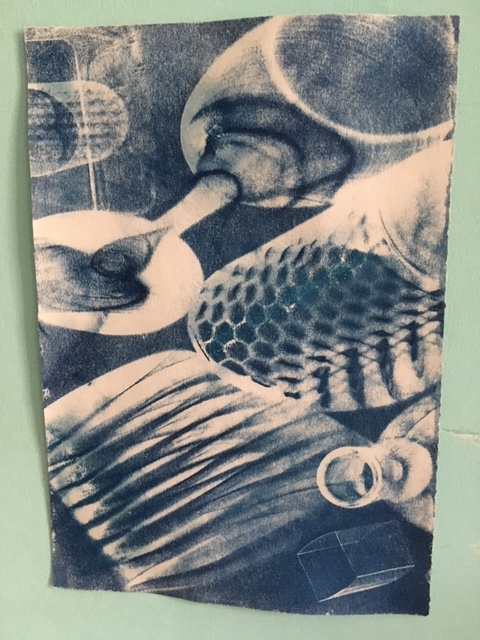by Fraser Hibbitt for the Carl Kruse Arts Blog
A cyanotype is created very easily. Whether it is a composition of any worth is harder to say. A little later in the day of photographic discovery, when the desire to successively sustain an image in print captivated scientists, the cyanotype was discovered. Immediately recognizable for its dark deep blue print.
Mix two ready-to-buy liquid compound chemicals (ferric ammonium citrate and potassium ferracyanide) in equal parts. Paint this mixture upon a surface, a piece of thick paper will do. Now, it is photosensitive and works as a basic photogram. Any object placed on the paper and exposed to the light will create the cyanotype. The development stage needs only water to wash off the chemicals.
In the 1850s, the botanist Anna Atkins used cyanotypes to record plant species in a scientific reference book British Algae: Cyanotype Impressions. Here is page after page of algae embedded in a deep blue. The delicacy and clarity of each species of plant in Atkins’ book has held, and many go happily collecting flowers of the field to try and replicate it, often, at first, with shoddy results.
The cyanotype process is intuitive, the chemicals are cheap and of little burden, but you are dependent, much more than film photography, on the sun. The exposure times vary rapidly between the movement of a cloud. The wind picks up and agitates your design which is already partially exposed on the print. You are made to play the guardian. The whole process, and this is part of its charm, feels primitive. Tentatively, the print is washed and forms start to appear, not the forms you imagined, and the thing looks drained of life, yet you know now where that life is.
There you start to see the freedom of the medium. The 19th century scientists working to perfect photographic methods were not as interested in strange results as we might be today, or an artist like Man Ray working in the early years of 20th century was. Experimentation in art tends not to have a goal in mind, rather the means are equated with the ends. The ’experiment’ of the photographic method was obvious to many in the 19th century: whether it produced a realistic print.
The chances that experiment produced were only useful by their fact of not being desired, not being what is supposed to be done. After all, when photography was patented, there was much made about its value to scientific research (Anna Atkins’ book was a first in illustrating a scientific textbook by photographic methods), only with an after nod to photography’s use in artistic study.

When photography met with aesthetics, they did not know what to say to each other, and aesthetics presumed photography was a kind of realistic painting without paint.
Disregarding the impulse for realism opens a way to seek an aesthetic. The cyanotype is perfect for a play between light and an object of choice. More specifically, it does very well with glass and their shadows, or see-through plastics. There is a reason that the glass has appeared in paintings for centuries, especially in the still-life as, among symbolic intent, a reflection of the artist’s skill. The glass with a light, natural or not, shining upon it reflects an incredible complexity, as if the light-wave is being fumbled incessantly, unable to be caught and unable to leave.
Luck has always been paramount to photography, see street photography, but also for experiment’s sake: the luck of chance composition. The cyanotype exposes the object, but you must trial for how long, calibrate. The strength of sunlight changes, you must change with it. The object returns from the print a dense block of white on the lovely blue, boring and dull, however there are waves and lines of interest, only there is hardly a clue as to how they came about. The next print. The shadow of a glass only, not the object, and to refine the light, you play with that shadow by more glass, glass upon glass if you have the space. The print returns and there is something of the sun traced upon the surface, through a glass lightly.
===========
The Carl Kruse Arts Blog — Ars Lumens — homepage is at https://carlkruse.net
Contact: carl AT carlkruse DOT com
Other articles by Fraser include: Thinking About Realism, The Art of Atari, and On Magical Thinking.
More info about Carl Kruse here.